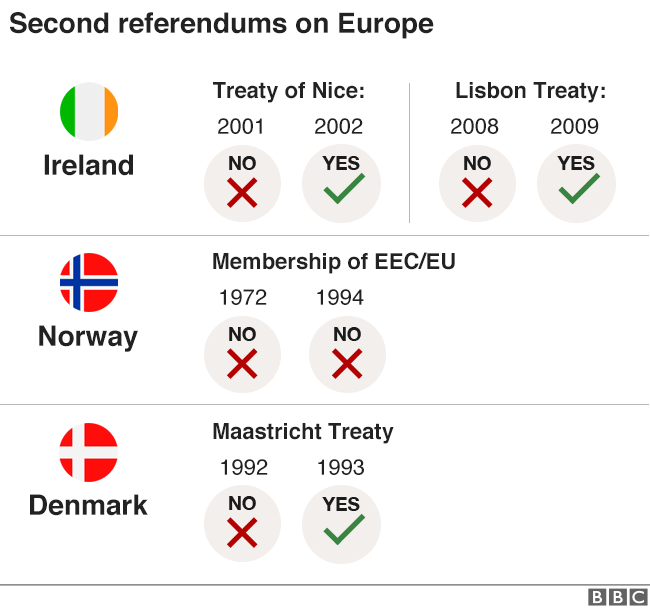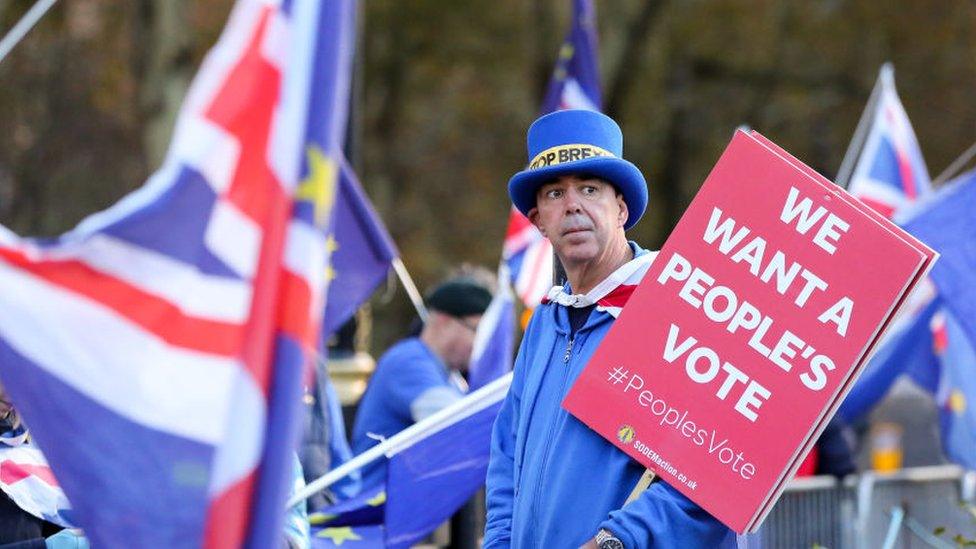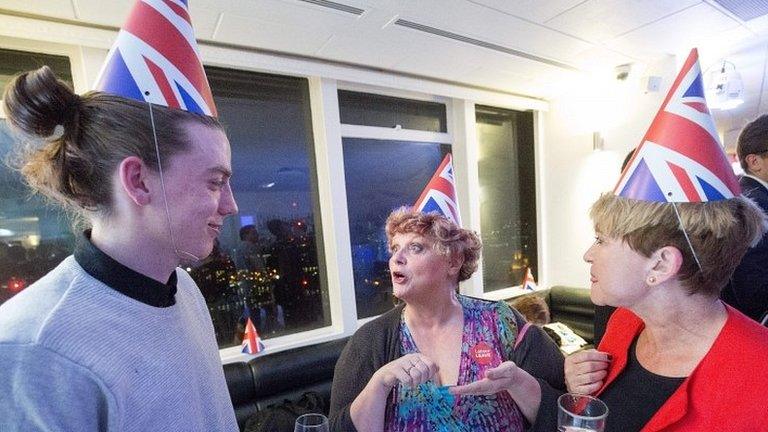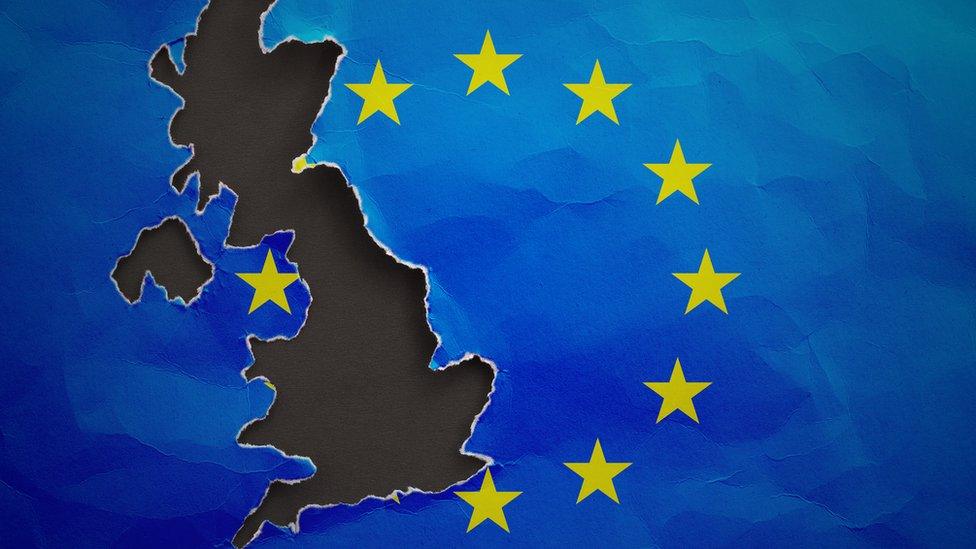Brexit: How Europe does second referendums
- Published
Could there be a second Brexit vote?
Another week goes by, and there's more Brexit confusion, and heightened calls for a second referendum.
Prime Minister Theresa May has warned such a vote would "break faith with the British people", but campaigners argue it may be the only way to solve the deadlock which is currently gripping Parliament.
Is it right to ask voters to take a view on the same issue more than once? If so, what circumstances should be proffered as a reason? And do people really change their minds in a matter of months - with a slight adjustment of terms, or a little more information - or does it take years and a substantial shift in culture or demographics?
A few countries in Europe have had that experience when a first referendum on a European Union issue didn't quite go the way the government of the day expected.
So what did these countries do - and can the UK learn anything from its neighbours?
Ireland: An exercise in determination
Ireland - unlike all other members of the EU - is legally obliged to put treaties to a vote before they can be implemented because they need to change their written constitution.
But because EU treaties have to be unanimous, a "no" vote also means the treaty cannot take effect anywhere else, which throws a bit of a spanner in the works.
What were they deciding?
Irish voters have twice rejected EU treaties.
In 2001, it was the Treaty of Nice - which amended the Maastricht Treaty and sought to prepare the institutions of the EU for its anticipated enlargement.
Then, seven years later, it was the turn of the Lisbon Treaty, which was an attempt to streamline the EU.
How did they vote?
Just 35% turned out to vote on the Treaty of Nice in 2001, with 54% backing "no".
In 2008, with the Lisbon Treaty, turnout was higher at 53%. However, the Irish once again rejected the change by 53.4% to 46.6%.
What happened next
In both cases, Ireland changed its mind.
In October 2002, more than 62% voted to back the Treaty of Nice on a turnout of almost 50%. Changing the people's minds would literally come down to vigorous campaigning and an amendment which promised to keep Ireland out of any future common European defence force.

The Lisbon Treaty was rejected in the 2008 vote
It also contained a proviso that any further votes on the Nice treaty would go through a parliamentary vote rather than a referendum.
And in 2009, just 16 months after the first attempt - with turnout just 5% higher - 67% of the country backed the Lisbon Treaty.
EU leaders - desperate to keep the treaty alive - had returned to the drawing board, and added what were described as important safeguards by the Irish.
Read more: Ireland and the EU - a special case
France: Overruled
What were they deciding?
The French were given the vote on the draft EU constitution in 2005.
How did they vote?
Almost 55% rejected the proposed constitution when it went to the ballot box in May 2005, despite the country's leaders campaigning for the "yes" vote.
What happened next?
After voters in France and the Netherlands rejected the constitution, EU leaders returned to the drawing board and came up with the Lisbon Treaty.
In many ways, it was similar to the constitution. However, instead of replacing the previous treaties, it was an amendment.
Despite the similarities, and support for a second referendum, the French government decided against putting the treaty forward for a vote.
Instead, they opted to put it to France's MPs and senators, who met in a special congress at Versailles in February 2008.
This time, the vote passed easily, by 560 to 181, with a number of MPs abstaining.
Norway: Not for turning
What were they deciding?
Norwegians were asked back in 1972 whether they wanted to join the EU - then known as the European Economic Community.
How did they vote?
They rejected it, with 53.5% voting against joining.
What happened next?
It was another 22 years before the Norwegians were asked again whether or not they wanted to become an EU member. In theory, the country's demographic and the nature of the EU itself had changed in that time - potentially leaving space for a different answer.

It wasn't to be. This time, 52.2% rejected membership.
But, despite the tightening margin and polls which at points have suggested the country is becoming more pro-EU, there has been no third attempt to join.
Denmark: A lesson learnt?
What were the Danes deciding?
It seems in the case of the Danish, it could be a case of once bitten, twice shy when it comes to potentially divisive referendums.
It goes back to 1992, when the Maastricht Treaty - which created the European Union and the single currency - was put to a vote in the northern European state.
How did they vote?
Just more than half - 50.7% - rejected the treaty, on a turnout of 83.1%.
What happened next?
A number of amendments were made, including exempting them from adopting the euro, and the referendum was held again.
This time, with turnout more than 3% higher, 56.7% voted in favour of the treaty.
More than a decade after the rejection - and then acceptance - of the Maastricht Treaty, Denmark watched as France and the Netherlands rejected the European constitution.
So, it made a decision: rather than risk a No vote, no referendum was held at all on either the constitution, or the Lisbon treaty which followed.
However, it should be noted they weren't the only ones to back out of the vote. Countries like the UK also backed out of a vote on the constitution, with - as mentioned above - only Ireland allowing a vote on the Lisbon Treaty.
- Published9 July 2019

- Published11 January 2018

- Published16 December 2018

- Published30 July 2019
